|
|
|
Sort Order |
|
|
|
Items / Page
|
|
|
|
|
|
|
| Srl | Item |
| 1 |
ID:
102513


|
|
|
|
|
| Publication |
2011.
|
| Summary/Abstract |
In the past few decades, planned contact interventions between groups in conflict have played an important role in attempts at improving intergroup relations and achieving peace and reconciliation. This article focuses on such reconciliation-aimed intergroup encounters between Israeli Jews and Palestinians that seek to reduce hostility and increase understanding and cooperation between the two nationalities. Like other contact interventions conducted in settings of intergroup conflict, encounters between Israeli Jews and Palestinians represent a paradoxical project: this is a project that aspires to generate equality and cooperation between groups that are embedded in a protracted asymmetrical conflict. Though existing research teaches us valuable lessons on the effectiveness of contact conducted under optimal conditions, little is said about contact between groups involved in asymmetrical protracted dispute. The goal of this analysis is to examine the evolution of reconciliation-aimed contact interventions between Israeli Jews and Palestinians in the past 20 years. The research method is qualitative, relying on ethnographic data assembled during the relevant period of time. The findings identify and trace the evolution of four major models of Jewish-Palestinian planned encounters: the Coexistence Model, the Joint Projects Model, the Confrontational Model, and the Narrative-Story-Telling Model. The strengths and limitations of each model in transforming intergroup attitudes in asymmetric conflict are discussed.
|
|
|
|
|
|
|
|
|
|
|
|
|
|
|
|
| 2 |
ID:
102505
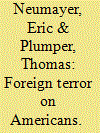

|
|
|
|
|
| Publication |
2011.
|
| Summary/Abstract |
Americans are a major target of international terrorism. Yet, terrorists from some countries are much more likely to attack American citizens than terrorists from other countries. Similarly, anti-American terrorism from a specific foreign country is much more prevalent during certain periods than others. This article develops a rational theory of international terrorism, which argues that attacking foreign nationals is of strategic value to terrorists even if they ultimately aim at gaining political influence in their home country. Attacking foreigners is the more attractive to domestic terrorists the more the terrorists' home government depends on military support from the foreign country. Applied to the US case, our theory predicts that more anti-American terrorism emanates from countries that receive more US military aid and arms transfers and in which more American military personnel are stationed, all relative to the country's own military capacity. Estimations from a directed country dyad sample over the period 1978 to 2005 support the predictions of our theory for both terrorist incidents involving Americans and terrorist killings of Americans as dependent variables. These results are robust to a wide range of changes to the empirical research design.
|
|
|
|
|
|
|
|
|
|
|
|
|
|
|
|
| 3 |
ID:
102511
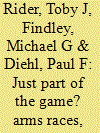

|
|
|
|
|
| Publication |
2011.
|
| Summary/Abstract |
In this study, we look at the relationship of arms races to war, with appropriate consideration of rivalries. Are arms races more common in rivalries than in lesser competitions? Are they merely a consequence of rivalry competitions? How do the patterns of arms races map with those of war in rivalries? We explore these concerns with an empirical examination of rivalry and non-rivalry populations in the 1816-2000 period. In brief, we find that: arms races occur most frequently in the context of enduring rivalries; arms races are more likely in the middle and later stages of rivalry; the frequency of arms races is higher in rivalries with war than rivalries that do not experience war; and only when arms races occur in the later phases of rivalries is there an increased chance of war. Our study narrows the scope of the arms race-war relationship relative to past studies, demonstrating that the arms race-war relationship is conditional on rivalry processes.
|
|
|
|
|
|
|
|
|
|
|
|
|
|
|
|
| 4 |
ID:
102512
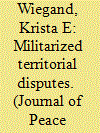

|
|
|
|
|
| Publication |
2011.
|
| Summary/Abstract |
States involved in territorial disputes are more likely initiate militarized interstate disputes to threaten or use force (MIDs) compared to states involved in other types of interstate disputes, when the disputed territory has strategic or ethnic value, and when the opposing states are contiguous, rivals, or have relative power parity. Though useful, these factors are static or rarely change over time, so they cannot explain the timing of an MID in a territorial dispute. It is not clear why a challenger state would threaten or use force at one point in the dispute, but not at another point. This study proposes that challenger states sometimes use MIDs not only to signal resolve to the opposing state in the territorial dispute, but to credibly demonstrate resolve to other adversaries in other disputes - an attempt to transfer reputation for resolve. To tackle the debate about transferability of reputation for resolve, the study empirically analyzes all territorial disputes from 1919 to 1995 and finds support that challenger states are more likely to initiate territorial MIDs as costly signals of resolve and credibility around the same time as another MID with a different adversary. Further analysis indicates that in terms of intensity level, challenger states are more likely to use threats, displays of force, or low intensity uses of force when initiating an MID to signal resolve to other states.
|
|
|
|
|
|
|
|
|
|
|
|
|
|
|
|
| 5 |
ID:
102509
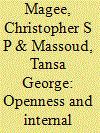

|
|
|
|
|
| Publication |
2011.
|
| Summary/Abstract |
This article examines the relationship between economic openness and internal conflict. The article first discusses different theoretical perspectives on how openness affects a country's internal stability and how internal conflict affects openness. Next, empirical estimates of the relationship between conflict and openness are presented, where conflict is measured with both a civil war dummy variable and an events dataset. The correlation between openness and conflict in the data is negative: more open countries have less internal conflict by some measures. However, internal conflict affects the level of openness, which suggests that openness should be treated as an endogenous variable. When the effect of openness on conflict is estimated using instrumental variables or full information maximum likelihood to control for endogeneity, openness does not significantly reduce internal conflict. There is robust evidence, on the other hand, that conflict within a country reduces its international trade. Together, these results suggest that the negative correlation between openness and conflict emerges because stability facilitates international trade rather than because trade flows reduce internal conflict.
|
|
|
|
|
|
|
|
|
|
|
|
|
|
|
|
| 6 |
ID:
102508
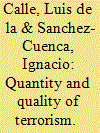

|
|
|
|
|
| Publication |
2011.
|
| Summary/Abstract |
This article presents a dataset of fatalities of domestic terrorism in Western European countries for the period 1965-2005. The Domestic Terrorism Victims (DTV) dataset, unlike others such as TWEED or GTD1, is based on local sources in each country and, consequently, it registers a higher number of killings. Measurement of the quantity of terrorism is therefore more accurate. The unit of observation is the fatality, not the attack, although the data can be transformed in terms of lethal attacks. Detailed information about each killing has been collected, making it possible to create new variables about the quality of violence: target selection, selectivity of the killings and their strategic aim. The ideology of the terrorists generates interesting variation in these three variables. The DTV is particularly suitable for hypothesis testing on the quantity and quality of terrorism.
|
|
|
|
|
|
|
|
|
|
|
|
|
|
|
|
| 7 |
ID:
102510
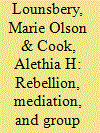

|
|
|
|
|
| Publication |
2011.
|
| Summary/Abstract |
Multilateral and diplomatic resolutions to intrastate conflicts are the preferred method of termination. However, mediated settlements tend toward failure and conflict recurrence. A significant factor in this failure is that government and groups are heterogeneous. While the demands, goals, preferences, and intentions of both sides are sometimes viewed as being held in common, they are potentially as diverse as the groups' members. Understanding the relationship between resolution efforts and group heterogeneity is complicated but crucial to improving mediation success. The current article examines all intrastate conflicts for the period 1945-1999, in order to test two competing propositions found in the literature on group change and the occurrence of mediation. The primary question of interest is whether group change tends to result from or precede mediation attempts. In other words, is group change an impetus to engage in mediation or do mediation processes tend to result in altered group characteristics. The findings support only the proposition that when governments engage rebels in mediation, rebel group changes are significantly more likely to occur than without mediation. The implications of the findings are also discussed.
|
|
|
|
|
|
|
|
|
|
|
|
|
|
|
|
| 8 |
ID:
102507


|
|
|
|
|
| Publication |
2011.
|
| Summary/Abstract |
Survey respondents in 14 countries representing 62% of the world's Muslim population indicate that approval of Islamist terror is not associated with religiosity, lack of education, poverty, or income dissatisfaction. Instead, it is associated with urban poverty. These results are consistent with the thesis that Islamist terrorists obtain support and recruits from the urban poor, who pursue their economic interests off the market in politics in collective groups. These groups compete over state rents, so a gain for one group is a loss for another, making terrorism of members of out-groups rational. The rise of militant Islam can be attributed to high rates of urbanization in many Muslim countries in recent decades, which fosters violence as rising groups seek to dislodge prior groups entrenched in power. Rising group leaders also compete over new urban followers, so they promote fears of out-groups and package in-group identities in ways that ring true for the urban poor. Because many of the urban poor are migrants from the countryside, popular packages are those which identify with traditional rural values and distinguish enemies as those associated with urban modernity and the secular groups already in power. Imams have an incentive to preach what audiences want to hear, so a mutated in-group version of Islam - Islamism - struck a chord in several large cities around the globe at the same time. With globalization of the media, in many developing countries the West is widely (albeit wrongly) perceived as an inimical out-group associated with urban modernity. The best political strategy to limit support and recruits for Islamist terrorist groups is to enhance the economic opportunities available for the urban poor and to provide them the needed services, such as access to health care and education, that many currently obtain from Islamist groups.
|
|
|
|
|
|
|
|
|
|
|
|
|
|
|
|
| 9 |
ID:
102506
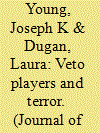

|
|
|
|
|
| Publication |
2011.
|
| Summary/Abstract |
Democratic regimes have been linked to terrorism for contending reasons, with some scholars claiming democracy increases terrorism and others claiming it decreases terror. Corroborating evidence has been used for both relationships leading to the following puzzle: why do some democratic regimes seem to foster terrorism while others do not? We offer an explanation based on Tsbelis's veto players theory. Beginning with the assumption that terror groups want to change government policy, we argue that the more veto players present in a political system, the more likely the system is to experience deadlock. Given the inability of societal actors to change policies through nonviolent and institutional participation, these systems will tend to generate more terror events. We also explore different methods for estimating terrorism models. We identify several ways to match the data with the proper statistical estimator and discuss implications for terrorism research. Finally, we use new data from the Global Terrorism Database (GTD) that was previously unavailable. These data allow us to use different operational definitions of terrorism and to identify homegrown terror events.
|
|
|
|
|
|
|
|
|
|
|
|
|
|
|
|
|
|
|
|
|